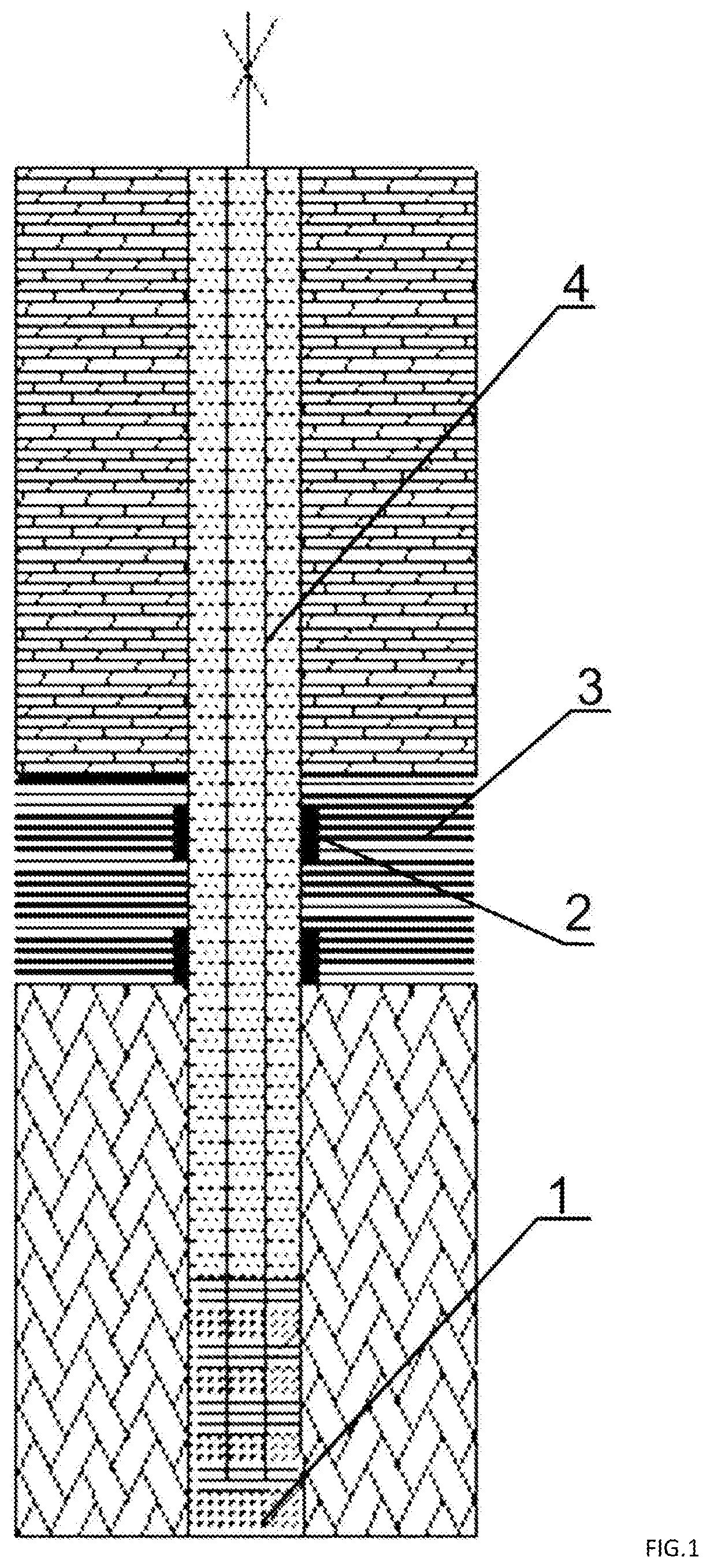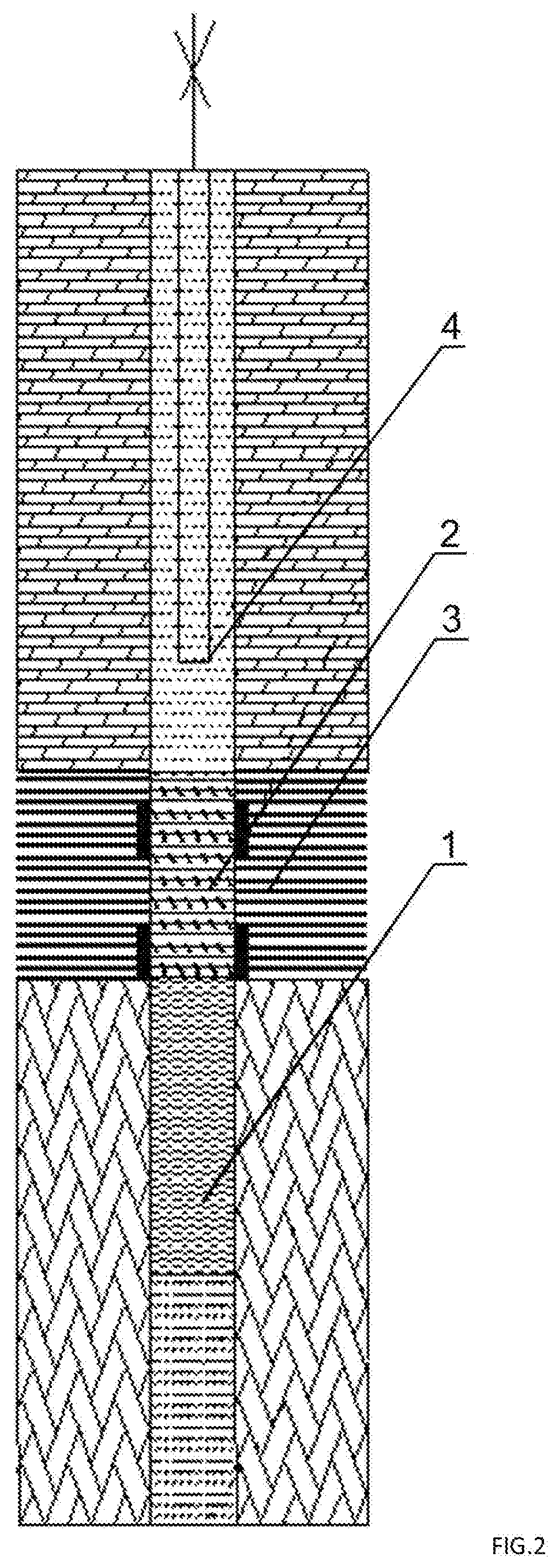Method for exerting a combined effect on the near-wellbore region of a producing formation
a near-wellbore region and producing formation technology, applied in the field of oil and gas, can solve the problems of increasing the flow rate of wells and difficult to recover reserves
- Summary
- Abstract
- Description
- Claims
- Application Information
AI Technical Summary
Benefits of technology
Problems solved by technology
Method used
Image
Examples
example no 1
[0081]Well No 798 Karazhanbas is located on the edge of the Karazhanbas field and does not contact any injection wells. Neighboring wells are characterized by identical productivity indicators, producing formation pressure is much lower than in wells with artificial maintenance of producing formation pressure. It has an effective formation thickness of 7 m. The well is 470 m deep with a perforation region of 396.2-401.0 m, 407.8-408.4 m, and 418.3-420.0 m. Before processing the well flow rate by fluid was 3 m3 / day; and the well flow rate by oil was 1.6 tons / day.
[0082]To carry out a complex effect on the near-wellbore region of the producing formation, process fluids No 1 (RM-1) and No 2 (RM-2) were prepared, a combustion initiator, which was used as sodium hydride NaH and passivated with an oxide film nanoaluminum powder Al at a ratio of 1:3 powder of sodium hydride NaH to the powder of nanoaluminum AI, respectively, and process fluid No 3 (RM-3).
[0083]The amount of RM-1 mixture wit...
example no 2
[0089]Well No 6047 in Karazhanbas. Well depth—475 m; perforation region: 407.4-409.9 m; 410.3-41 1.3 m; 428.8-432.8 m; 442-446.4 m; 447.2-448.7 m. Productivity data before processing: well flow rate by fluid—31 m3; well flow rate—2.3 tons / day.
[0090]To carry out a complex effect on the near-wellbore region of the producing formation, process fluids No 1 (RM-1) and No 2 (RM-2) were prepared, a combustion initiator, sodium hydride NaH, was used and passivated with an oxide film nanoaluminum powder Al at a ratio of 1:3 powder of sodium hydride NaH to powder nanoaluminum Al, respectively, and process fluid No 3 (RM-3).
[0091]The amount of RM-1 mixture with a density of 1.3 g / cm3 was 300 l or 390 kg, of which 185.4 kg of ammonium nitrate NH4NO3, 11.0 kg of sodium hydride NaH, 33.0 kg of nanoaluminum AI powder, hydrazine nitrate N2H5NO3—18.6 kg, oxamide nitrate C2O2(NH2)2.HNO3—5.7 kg, dihydroxymethylcarborane C4H16B10O2 (99.9%)—11.8 kg, hydrocarbon fuel—29.4 kg, sodium chloride NaCl—19.5 kg...
example no 3
[0097]Well No 3332 Zhetybai. It has been operating for more than 25 years, neighboring wells are characterized by identical productivity indicators. It is characterized by a low water cut (10%) and a strong gas effect. It has an effective formation thickness of 9 meters. The perforation region is: 2357.0-2360.5 m; 2364.5-2370.5 m.
[0098]Density of degassed oil: 0.84 g / cm3, asphalt / resinous / paraffinic substances: up to 28.6%. Oil solidification temperature: +30° C. Producing formation pressure: 173 atm. Downhole pressure: 159 atm.
[0099]The average daily productivity 3 months before the treatment: fluid flow rate—5 m3; oil flow rate—3.8 tons / day.
[0100]To carry out a complex effect on the near-wellbore region of the producing formation, process fluids No 1 (RM-1) and No 2 (RM-2) were prepared, a combustion initiator, which was used sodium hydride NaH and passivated with an oxide film nanoaluminum powder Al at a ratio of 1:3 powder of sodium hydride NaH to the powder of nanoaluminum AI, ...
PUM
| Property | Measurement | Unit |
|---|---|---|
| height | aaaaa | aaaaa |
| temperature | aaaaa | aaaaa |
| temperature | aaaaa | aaaaa |
Abstract
Description
Claims
Application Information
 Login to View More
Login to View More - R&D
- Intellectual Property
- Life Sciences
- Materials
- Tech Scout
- Unparalleled Data Quality
- Higher Quality Content
- 60% Fewer Hallucinations
Browse by: Latest US Patents, China's latest patents, Technical Efficacy Thesaurus, Application Domain, Technology Topic, Popular Technical Reports.
© 2025 PatSnap. All rights reserved.Legal|Privacy policy|Modern Slavery Act Transparency Statement|Sitemap|About US| Contact US: help@patsnap.com



